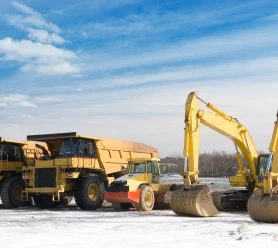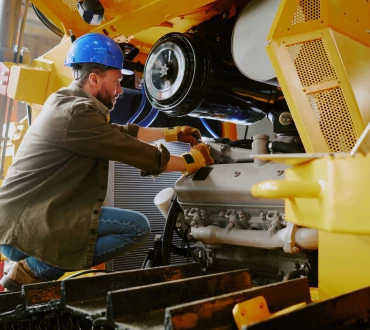Smart managers know that the key to maintaining productivity and minimizing downtime lies in keeping their dozers’ undercarriages in top condition. In fact, it’s said that up to half of a dozer's total maintenance costs are tied to the undercarriage. While modern sensors and telematics can help monitor many parts of your equipment, the undercarriage still requires the human touch. Regular inspection with your eyes and hands is the best way to keep it running smoothly.
Understanding Undercarriage Life and Wear
The typical life expectancy of a dozer undercarriage is around 4,000 hours, but this can vary depending on how the machine is used. Different parts of the undercarriage will wear out at different rates depending on the application. Here are a few common wear patterns:
Sprocket Segments: These often wear out first, especially in abrasive conditions.
Track Shoes: In harsher rock conditions, track shoes might be the first to show signs of wear.
Monitoring Bushing Turn and Wear
To get the maximum life out of your dozer’s undercarriage, it’s essential to monitor bushing and sprocket wear. Measuring the wear helps determine if a bushing turn is necessary. Regular bushings turns will ensure the longevity of the link and roller system. Having a discussion about the timing of these maintenance tasks can save you from premature wear and costly repairs down the line.
Sprocket Replacement and Roller Rotation
When your machine reaches around 2,000 hours, it’s a good idea to check the sprockets for wear and replace any worn ones. Replacing sprockets at this stage helps avoid having to make another repair visit shortly afterward.
Rollers, like tires on a car, can be rotated to extend their life. The front and rear rollers typically wear more quickly than the center rollers, so rotating them helps distribute the wear more evenly. Carrier rollers, on the other hand, can run until they fail, and while they’re not a costly repair, monitoring them can prevent surprises.
Checking for Frame and Alignment Issues
Just like with a car, alignment issues on your dozer will cause uneven and accelerated wear on the undercarriage. Misaligned components, such as the equalizer bar, pivot shafts, or roller frame, can lead to uneven track wear and put extra strain on the system. Here’s a quick way to check alignment on a six-way bladed dozer:
Lift the Machine: Push the blade into the ground and lift the machine slightly.
Tilt the Machine: Tilt the machine to either side.
Check for Tightness: While lifted, check the tightness of the equalizer bar and pivot shafts. Any movement here is a sign of trouble.
If you don’t want to lift the machine, you can also check for signs of misalignment on flat ground:
Inspect front idlers and carrier rollers for abnormal wear.
Look for uneven wear on the sprockets.
The Importance of Track Tension
Unmanaged track sag is one of the most detrimental factors to your dozer’s health. If the track tension isn’t optimized for the soil conditions you’re working in, it can cause excessive wear. Keeping your dozer clean and free of debris between the frame and undercarriage is essential. Material buildup in these areas can accelerate wear and may hide leaks, faulty seals, or worn-out zerks.
Wear Factors: What You Can’t Control
Certain factors, such as the type of soil you’re working in, can accelerate undercarriage wear. While you can’t control the conditions, understanding them can help minimize damage:
Soil with High Quartz or Moisture Levels: Quartz is highly abrasive, and moisture in the soil turns it into a lapping compound that grinds down components faster than other soil types.
Tips for Minimizing Wear on the Jobsite
To extend the life of your dozer’s undercarriage, there are several best practices you can follow:
Minimize New Experiences: Avoid sudden movements, new forces, or unfamiliar environments that put added strain on your equipment.
Shorter Push Distances: If possible, minimize long push distances or high speeds, as these accelerate wear.
Avoid Excessive Turning: Excessive turning causes additional wear, especially on tracks.
Limit Uneven Loading: Avoid bench cutting operations or uneven loading that can strain the undercarriage.
Keep It Clean: Regularly clean the undercarriage to prevent debris from causing wear and hiding potential issues.
Monitor Soil Moisture Content: Moist soil can be abrasive, so understanding its impact on your machine can help you anticipate wear.
By analyzing your jobsite and the specific challenges it presents, you can adjust your operations and better plan for maintenance. These insights should be factored into your bid models and operating expenses to ensure accurate cost estimates.
Get the Parts You Need
Ready to extend the life of your dozer? Keeping your undercarriage in top shape is essential to maintaining efficiency and reducing downtime. If you need replacement parts for your dozer, give us a call! We offer a wide selection of high-quality parts to keep your machine running smoothly so you can focus on your next big earth-moving project.

Consult our knowledgeable staff for your wear part questions.
Related

Cold Weather Maintenance Tips for Construction Machines
Cold weather can take a significant toll on construction machinery, leading to issues like reduced battery performance, increased wear on parts, and difficulty starting equipment. To keep your construction machines running smoothly during the winter months, proper maintenance is essential.
- Maintenance & Repair
- December 12, 2024


